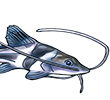Unmack, PJ, AP Bennin, EM Habit, PF Vitoriano & JB Johnson, 2009. Impact of ocean barriers, topography, and glaciation on the phylogeography of the catfish Trichomycterus areolatus (Teleostei: Trichomycteridae) in Chile. Biological Journal of the Linnean Society 97: 876–892.
Abstract
We examined the role of several earth history events on the phylogeographic distribution of the catfish Trichomycterus areolatus in Chile using the cytochrome b gene. We explored three biogeographic hypotheses: that sea level changes have resulted in the isolation of populations by drainages; that glaciation has impacted genetic diversity; and that ichthyological subprovince boundaries correspond to phylogeographic breaks in our focal species. We found seven well-supported clades within T. areolatus with high levels of genetic divergence. The strongest signal in our data was for an important role of sea level changes structuring populations. Five of the seven clades mapped cleanly to the geographic landscape and breaks corresponded closely to areas of narrowest continental shelf. In addition, few haplotypes were shared between rivers within clades, suggesting that only limited local movement of individuals has occurred. There was no relationship between the levels of genetic diversity and the proportion of individual drainages covered by glaciers during the last glacial maximum. Two phylogeographic breaks within T. areolatus did match the two previously identified faunal boundaries, but we found three additional breaks, which suggests that faunal breaks have only limited utility in explaining phylogeographic patterns. These results imply that the narrow continental shelf coupled with sea level changes had a strong influence on the obligate freshwater fishes in Chile.
Phylogeography of Trichomycterus areolatus in Chile
- Silurus
- Posts: 12420
- Joined: 31 Dec 2002, 11:35
- I've donated: $12.00!
- My articles: 55
- My images: 893
- My catfish: 1
- My cats species list: 90 (i:1, k:0)
- Spotted: 424
- Location 1: Singapore
- Location 2: Moderator Emeritus





